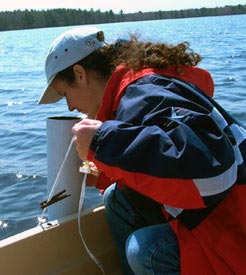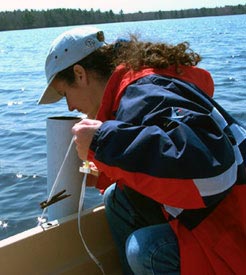 Increasing temperatures cause drop in Rhode Island water quality
Increasing temperatures cause drop in Rhode Island water quality
KINGSTON, R.I. � March 8, 2007 � Water quality in Rhode Island�s lakes, ponds, streams and estuaries was affected negatively in the last two years by increasing temperatures and more intense rainstorms, according to data from the University of Rhode Island�s Watershed Watch program.
Temperatures in some lakes around the state reached 86 degrees at times in 2005 and 2006, which is high enough to reduce dissolved oxygen levels and stress organisms living in the water. The mild fall and winter increased the growing season for algae, which also reduces oxygen levels when they die. And increasingly severe rainstorms caused additional run-off from roadways and lawns to enter water bodies, further degrading their water quality and reducing groundwater recharge.
�We can�t be sure that this is direct evidence of global warming, but it certainly falls in line with global weather trends,� said Elizabeth Herron, Watershed Watch program coordinator. �And it�s very different from what we experienced in the first years of our program 20 years ago.�
Expanded monitoring of Greenwich Bay in 2006, for instance, turned up several occasions when there was low or no detectable dissolved oxygen, which was the likely culprit of the massive fish kill that occurred there in 2003. Determine which water bodies are most sensitive to changes in weather and run-off patterns is the first step in determining which management practices � such as preserving and restoring vegetation along waterways or reducing the use of fertilizers on lawns � can help to reduce impacts.
Despite these results and the highly developed nature of the state, Herron and Watershed Watch Director Linda Green note that overall water quality in Rhode Island hasn�t diminished significantly, for which they credit the state�s strong environmental regulations.
To ensure that this vital stream of data continues to flow, the University of Rhode Island�s Watershed Watch program, which celebrates its 20th anniversary this year, is seeking additional volunteers to monitor water bodies in 2007. Launched in 1988 with 25 volunteers monitoring a dozen lakes, the program has grown to 350 volunteers and 220 sites on 100 different water bodies throughout the state.
�The data collected by our volunteers is used by watershed organizations, policy makers, regulators and state and local officials to make decisions that affect the environmental health of the state and its residents,� said Herron.
An introduction to the Watershed Watch program and classroom training for new Watershed Watch volunteers will be held Saturday, March 24 from 9 a.m. to noon and repeated Wednesday, April 4 from 6 to 9 p.m. in the Coastal Institute building on URI�s Kingston campus. The required field training session will take place on April 14, April 21 and May 1. The program is sponsored by URI�s Cooperative Extension in the College of the Environment and Life Sciences, the state Department of Environmental Management, and many local organizations.
Volunteers come from all walks of life and are of all ages, occupations, educational backgrounds and interests. Each potential volunteer is matched to a specific location that they will be in charge of monitoring. �Ideally we try to find more than one volunteer per site so they can share monitoring duties,� noted Green. �We�re also seeing a growing number of students who become monitors to amass community service hours.� Since ponds, lakes and some salt water sites are monitored at their deepest point, a boat, canoe or kayak is needed, as well as some free time once a week in the middle of the day. River and stream sites, monitored early in the morning at mid-stream, are generally more accessible, with few requiring a boat for access.
The monitoring season begins in May and ends in mid-October. Once a week on a day of their choice, volunteers monitor for water clarity and temperature. Every two weeks they also monitor algae concentrations and dissolved oxygen. On several designated dates, volunteers collect water samples that are analyzed at URI for nutrients, acidity and bacteria.
For more information or to register for the training sessions, contact Herron at 401-874-4552 or at uriww@etal.uri.edu. Visit the program�s web site at www.uri.edu/ce/wq/ww for detailed information about the program and its list of 2007 monitoring locations.

